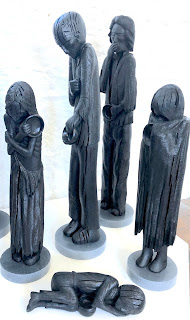The Famine in Country Tipperary
 |
| From the exhibition Dark Shadows by Artist Kieran Tuohy |
Here is what FamilySearch has to say about the population of Tipperary: "The population was 346,896 in 1821 and grew to 435,553. It was greatly affected by the potato famine and its population decreased to 331,567 in 1851." This means that all of the births from 1821 - 1851 were affectively cancelled. They continue: "The population continued to decrease until it was only 141,015 in 1926. In 2006, the population was 149,244."
In general Ireland is still not at pre-famine population levels.
The problem with determining if an individual died during the famine, is that the records of the deaths aren't as easy to find as the births, and there is less information about the dead. We know that thousands died and thousands left the island. FindMyPast.com is a wonderful database to use for finding all sorts of Irish records. They are probably one of the best sources for baptismal records. All of the original church records, that exist online, can also be found at the National Library of Ireland's Catholic Parish Registers database: https://registers.nli.ie/
The number of death records for County Tipperary is extremely lacking. A search on FindMyPast, reveals only 598 records and these are not from Catholic Church records. A good portion of these are from Quaker records, and another from the Tipperary Clans Archive. A search of the Catholic Parish Records for Gortnhoe Glengoole parish (where the Maher's worshiped) will reveal no death records, only births and marriages. The civil registers, reveal only 7 deaths. The lack of records can be seen here: Roman Catholic Records in Tipperary
Every individual in our family tree has a story to tell. And each of these stories has information that is still useful today. But, even if it wasn't, in discovering their stories we begin to see them as human beings not so unlike ourselves and we begin to see how their journeys have lead us, in many ways, to where we are today.
Comments
Post a Comment